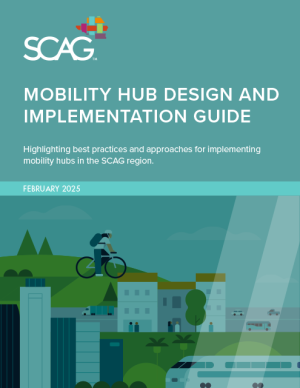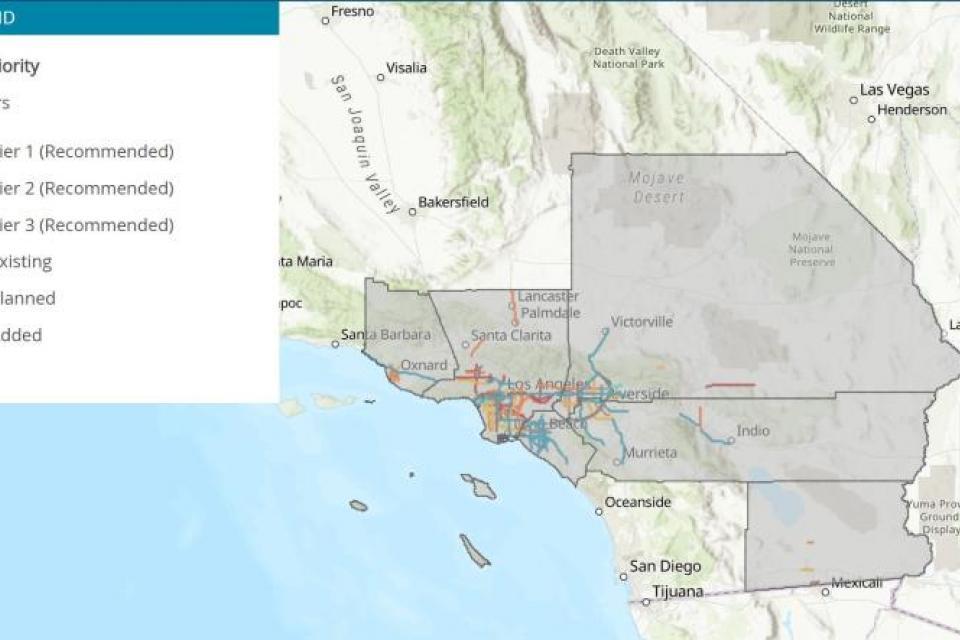Transit
SCAG works with transit operators, the region’s transportation planning agencies, and the California Department of Transportation (Caltrans) to develop goals, objectives, plans, and policies to provide effective and sustainable transit options for the region.
A key component of this partnership is the Regional Transit Technical Advisory Committee (RTTAC), composed of representatives from Caltrans, the region’s county transportation commissions, and various transit operators. The RTTAC provides a forum for input on the development of the regional transportation plan, the Federal Transportation Improvement Program, and SCAG’s Overall Work Program. Formal relationships and interactions between the above agencies, including RTTAC participation, are governed by a set of memorandums of understanding (MOUs) updated in 2018. The MOUs describe the roles and responsibilities of each party in carrying out and supporting the metropolitan planning and programming processes and include provisions for data sharing and the coordinated development of transit performance targets. These MOUs were executed under 23 Code of Federal Regulation 450.310(b).
Studies & Publications
- Transportation Trends Report June 2025
- "Transit Priority Best Practices" Report
- "SwissCal Conference on the Swiss Public Transportation Ecosystem"
- "Regional Dedicated Transit Lanes Study Final Report"
- Regional Dedicated Lanes Interactive Map
- Mobility as a Service Feasibility White Paper
- Mobility as a Service StoryMap
- SCAG-UCLA "Falling Transit Ridership" Study
- SoCal 511
Adaptation and Resilience Planning
In fiscal year 2017-19, SCAG prepared resources for providers of public transportation in the region to respond to expected challenges resulting from global climate change. This work, funded by a Caltrans Statewide and Urban Transportation Planning Grant, assisted transit providers with incorporating climate change adaptation into their existing processes.
SCAG produced a toolbox of resources to be used to identify critical assets and routes, integrate climate considerations into local and regional planning processes, and implement adaptation practices to improve transit system resilience while complying with state and federal regulations. This toolbox of resources was developed through a collaborative process with local agencies, through in-person workshops and panel reviews, to assist transit agencies in completing these activities with limited resources.
11 Elements of the Final “Climate Resilience Toolbox”
- Projected Changes in Climate in the SCAG Region
- Assessing Vulnerability and Consequences: Getting Started
- Integrating Climate Change into Transit Planning Processes
- How to Obtain Detailed Climate Projection Data
- Assessing Criticality
- Sensitivity Matrix
- Example Adaptation Measures
- Tips for Selecting and Implementing Adaptation Measures
- Climate Resilience Planning Template
- Contingency Plan Template
- Transit Resiliency Funding Opportunities
Americans With Disabilities Act (ADA) Paratransit Demand Forecast Tool
Federal statute establishes ADA complementary paratransit as a civil right, intended to serve as a “safety net” for persons with disabilities who cannot use fixed-route bus or rail service because of a disability.
SCAG initiated a study in 2019 to develop a tool to assist the agency and transit providers with developing long term forecasts of demand for ADA paratransit services. The ADA Paratransit Demand Forecast Tool, the first of its kind in the region, will help to inform SCAG’s long-range planning for ADA Paratransit needs in Southern California.
It is intended to help measure the performance of plans in meeting the mobility needs of elderly and disabled residents, and to estimate the resources necessary to meet future needs. The tool can also be used to support the region’s ADA paratransit providers in their planning and budgeting activities.
Download
ADA Paratransit Demand Forecast Tool
ADA Paratransit Demand Forecast Tool – User Guide
Workshop
The ADA Paratransit Demand Forecast Tool, outputs and associated data are provided “as is” without warranty of any kind, whether expressed, implied, statutory, or otherwise including but not limited to, the implied warranties of merchantability and fitness for a particular purpose.
Mobility Hubs
Mobility hubs are places where people connect with multiple modes of transportation safely, comfortably, and accessibly. Mobility hubs offer a range of transportation options (typically at least two) that seamlessly connect and interact with each other, providing the infrastructure foundation for multimodal trip planning with essential resources for a safe and convenient transfer between transportation modes.
Designing Mobility Hubs for Southern California
SCAG developed the Local Jurisdictional Guidance for Mobility Hubs, which includes high-level siting and planning guidance for our 191 member cities and six counties, covering urban, rural, and suburban land uses.
The planning guide will be a tool for local and regional stakeholders to assist in developing mobility hubs.
Vision for Mobility Hubs
SCAG aims to support development of a network of regional mobility hubs that prioritizes people through universal accessibility, safety, and community integration. These hubs will seamlessly connect two or more modes of transportation: transit, bike, pedestrian, shared mobility services, carpooling and vanpooling, and on-demand services.
Through a flexible and context-sensitive design approach that addresses climate challenges, SCAG’s vision for mobility hubs empowers individuals to move efficiently and sustainably, fostering vibrant, inclusive, and resilient communities.
SCAG’s strategy is to focus targeted investments in a set of prioritized mobility hubs distributed across the region.
SCAG’s Regional Council adopted Connect SoCal 2024 in April 2024, which included the region’s mobility hubs strategy.
SCAG’s strategy is to focus targeted investments in a set of prioritized mobility hubs distributed across the region and has included mobility hubs as one of our program areas for its Regional Pilot Initiative.
Mobility Hub Design and Implementation Guide

The SCAG “Mobility Hub Design and Implementation Guide” highlights best practices for implementing mobility hubs and mobility hub networks in the SCAG region. This guide discusses how to locate and prioritize candidate mobility hub sites, design and optimize sites, secure funding, explore partnership opportunities, and more.
The Connect SoCal 2024 Regional Transportation Plan/Sustainable Communities Strategy identified mobility hubs as a regional strategic investment to increase multimodal connectivity, manage the existing transportation system, and improve the traveler experience.
SCAG’s “Mobility Hub Design and Implementation Guide” provides a supportive framework for local implementation, equipping cities and local partners to conceptualize, design, and implement mobility hubs.
To learn more about the potential of mobility hubs to create new multimodal transportation options for communities all over Southern California, read the “Mobility Hub Design and Implementation Guide.”
Resources
Innovative Clean Transit Regional Assessment Study
In December 2018, the California Air Resource Board (CARB) adopted the Innovative Clean Transit (ICT) (Cal. Code Regs. Tit. 13 § 2023.1) regulation, which requires all public transit agencies to gradually transition to 100-percent zero-emission bus (ZEB) fleets by 2040. The regulation requires transit agencies to publish ZEB Rollout Plans and requires transit agencies to buy different ZEB sizes by year. SCAG affirmed its commitment to supporting efforts to advance a zero-emission transportation system through its adoption of Resolution No. 23-654-5 (April 2023), which established the Clean Transportation Technology Policy to support development, commercialization, and deployment of a zero-emission transportation system.
To support the region in meeting the transition deadline, SCAG kicked off the “Innovative Clean Transit Regional Assessment Study” in summer 2025. The study will support the region in efforts to transition to ZEBs by 2040 by assessing the region’s transit operators’ efforts to develop and implement ZEB Rollout Plans, evaluating readiness of the region to transition to zero-emission transit fleets, and the ongoing efforts aimed at transitioning to clean transit solutions throughout the region.
Study Objectives
The “ICT Regional Assessment Study” will:
- Assess ongoing efforts to transition to clean transit solutions throughout the region, including evaluations of existing fleets and supporting infrastructure.
- Identify any existing gaps within ZEB rollout plans and explore avenues for improvement and enhancement.
- Explore opportunities for enhanced coordination across agencies to streamline efforts and maximize effectiveness.
- Identify potential roles for SCAG in facilitating the transition to clean transit, including exploring opportunities for assistance through funding sources administered by SCAG.
Stakeholder Engagement
The project team will seek feedback from SCAG’s policy committees and the Regional Transit Technical Advisory Committee throughout the study. This engagement will begin with reviewing the goals and objectives of the study. In addition, the project team will assemble a list of transit agencies, bus manufacturers, charging infrastructure manufacturers, and utility providers, and reach out to them for information about the ZEB market, best practices, and existing conditions. Targeted outreach may be conducted through surveys and one-on-one meetings. Feedback gathered during this targeted outreach will help shape the implementation action plan and final report.
Project Timeline
The study kicked off summer 2025 and is expected to be completed by summer 2026. Key deliverables include a Zero-Emission Transit Vehicle Deployment Toolkit and implementation action plan, which can be incorporated into the “Innovative Clean Transit Regional Assessment Study.”
For more information, read the September 2025 staff report to the SCAG Energy and Environment Committee.
Contact
Priscilla Freduah-Agyemang
(213) 236-1973
contact@scag.ca.gov
